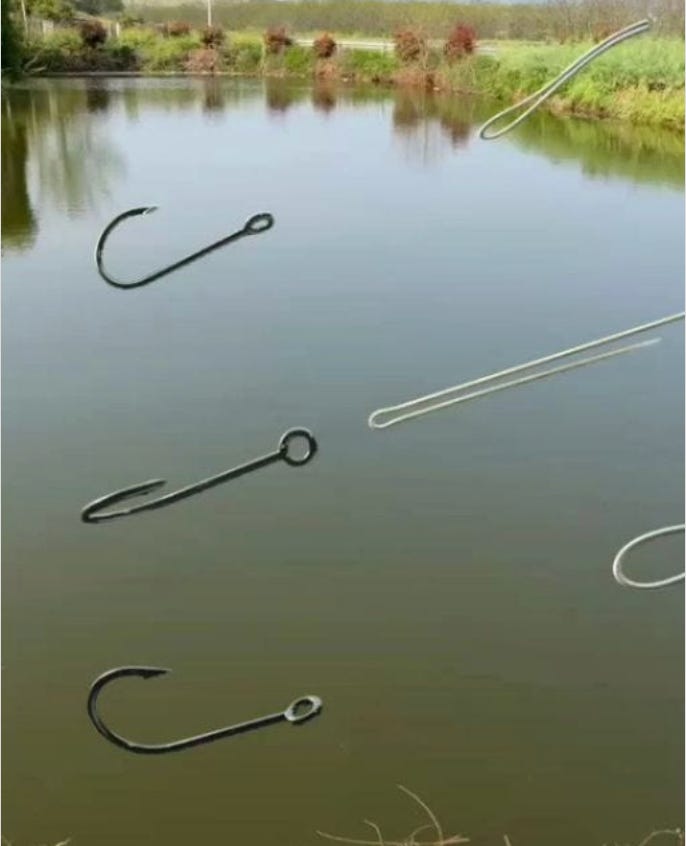How to Tie a Fishing Knot
Gar's Tips & Tools - Issue #164
Gareth’s Tips, Tools, and Shop Tales is published by Cool Tools Lab. To receive the newsletter a week early, sign up here.
– Send me a tip or tool recommendation.
–Tell me a shop tale.
-Buy my books (Tips and Tales from the Workshop Vol. 1, Vol. 2).
–Advertise your product, service, newsletter, app, book, tool, or anything you’d like to share with GT&T readers.
How to Tie a Fishing Knot

I love animations of knot tying, so I find this animation of how to tie a fishing hook knot extremely satisfying.
Understanding “Blue Marking Fluid”
I have known about (and even used) machinist blue marking fluid over the years. But until this Adam Savage video, I didn’t actually know what it was composed of (blue lacquer) and what it’s specifically formulated to do (reflect scribe markings better than black or other colors and to be the only thing that’s scratched through — not the work piece itself). This explanation comes by way of Adam explaining why his hands were blue in a recent video. He dumped an entire bottle of marking fluid all over his mill and himself. Twice! Now that’s a bad day in the shop!
I also felt a bit exonerated by Adam referring to it as “blueing.” In Issue #67, I wrote an apology after I got heat for referring to blue marking fluid as blueing. Apparently the machinist I heard the term from was not the only one who used blue marking fluid and blueing interchangeably.
Project Enclosure Basics
If you’re like me, you often don’t put much thought into your project enclosure, or don’t bother with one at all. But if it’s a truly meaningful electronics project that’s meant to be use and interacted with, especially by others, a proper, well-designed project enclosure is an essential part of the build. In this video, Becky Stern looks at the wide range of enclosure candidates, from recycled takeout containers to commercial enclosures. There are lots of suggestions here for enclosure components you might not have thought about, like plastic, cardboard, and foamcore. She also covers unique options like craft store shadow boxes and clear plastic memorabilia cases. Lastly, Becky touches on “bespoke” and custom enclosures made with 3D printing and CNC milling. She also goes into some tools and techniques that are useful when wiring up your enclosure.
Bucket Buddies

This week, I ran into two accessories you can add to those ubiquitous plastic 5 gallon home store buckets we all seem to have too many of. On Instagram, I ran across the Project Source QuikLid ClipOn Dust Pan. This turns your bucket into a dust pan and trash can for cleaning up all of your “shop glitter.”

And in the latest Family Handyman issue (Sept 2023), they recommend the Bucket Builder. These are thick plastic bucket adapters designed to turn 5 gallon plastic buckets into temporary sawhorses or work tables. The adapters can be used between buckets to raise the height of the work surface. The Builder Builders are priced at $28 for 4 or $48 for 8.
Getting Started in Home Powder Coating
In this BlondiHacks video, Quinn does an excellent job of walking us through how to get started in home powder coating. As she points out, it’s not as hard, expensive, or fussy as you might think. If you’ve ever flirted with the idea of getting into powder coating, you will likely want to take the plunge after watching this video.
Using White Bread to Stop a Plumbing Leak?
In this See Jane Drill video, Leah shows an old plumber’s hack where you can temporarily stop a pipe leak with white bread. It’s for situation when you need to sweat on a new pipe and the wet, leaking existing pipe won’t allow you to properly heat it. The bread will stop the flow long enough to add the new pipe.
Maker’s Muse

Is it just me or is there something intensely satisfying about watching this bird-like machine picker ripping apart vehicles and deftly sorting the parts? Here’s a video showing the entire machine and its human operator.
Kitchen Hack: Cooking Pasta IN the Sauce

Seeing an article in the wonderful cooking magazine, Milk Street, my wife and I decided to try this. Instead of boiling water and cooking the pasta separately, you simply toss it into the pot with your sauce. You do need to keep an eye on the liquid level, stirring and adding more water so that the pasta doesn’t stick. Cooking the pasta this way infuses it with the flavor of the sauce, not starchy water. Saves time and water, too! Try it and let me know what you think.
Shop Talk

Reader Marcel Boudreau writes:
I tried the hack of using a rubber band around a paint can as a place to wipe excess paint from your brush, but I found it’s hard to get the band around the can without spilling the paint, especially with a new full can and only two hands.
Instead I use some blue painters tape (always at hand when I’m painting), to add a wiping surface and keeping paint out of the can’s rim. It also works with pretty much any shape/size container you’re using.
I find it hard to believe I haven’t seen this tip elsewhere, so I cannot necessarily claim I’m the first.
09/13/23





